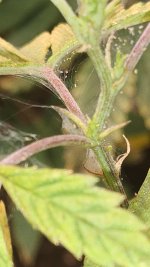GlandualFever
Active member
Hi, it's my first time using predator mite sachets from Koppert. I had a thrips problem, and decided to go the predator route, and for good measure I bought some preventative for spider mites as well. Now I didn't see any mites before I got the predators, only thrips. Fast forward 1 week and I now have webbing on the plants ( thankfully I'm in veg) . I've looked for a comprehensive answer to this and cannot find one. Do predator mites Web? There are clusters of webbing which have collections of mites within. Its really baffling because there was no sign or damage from spider mites before the predators were applied. Would appreciate some experienced members to chime in here. Thanks





